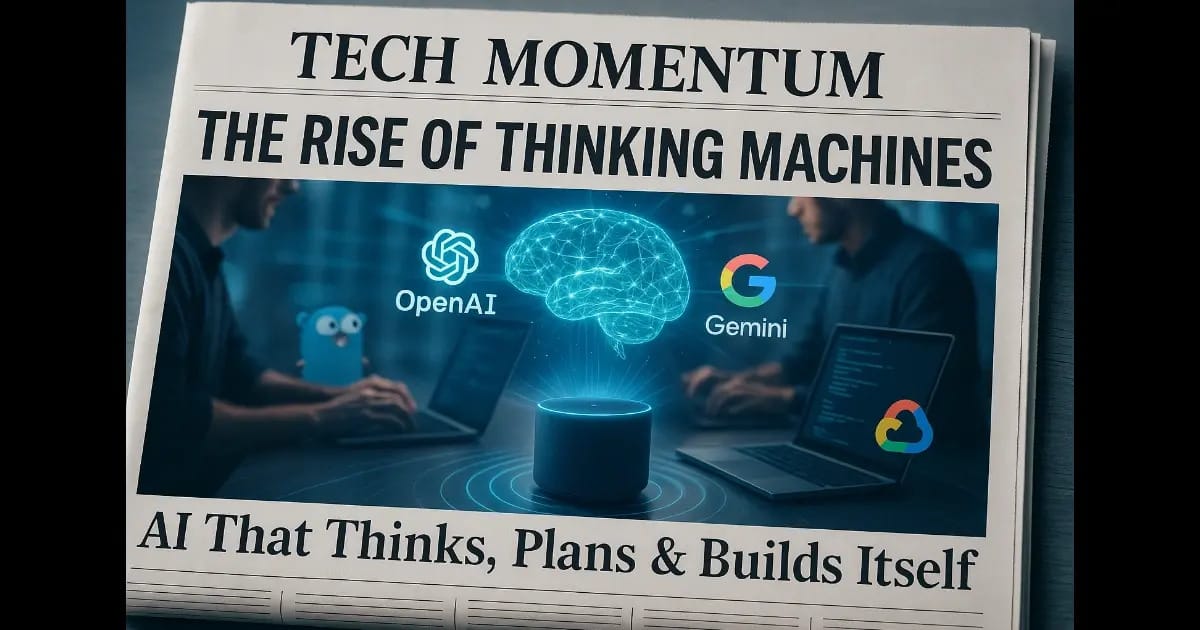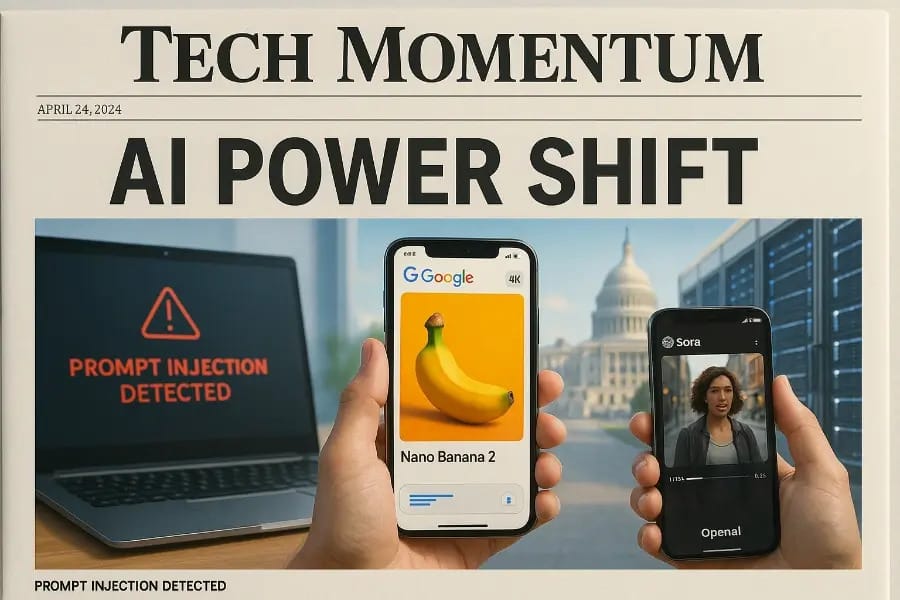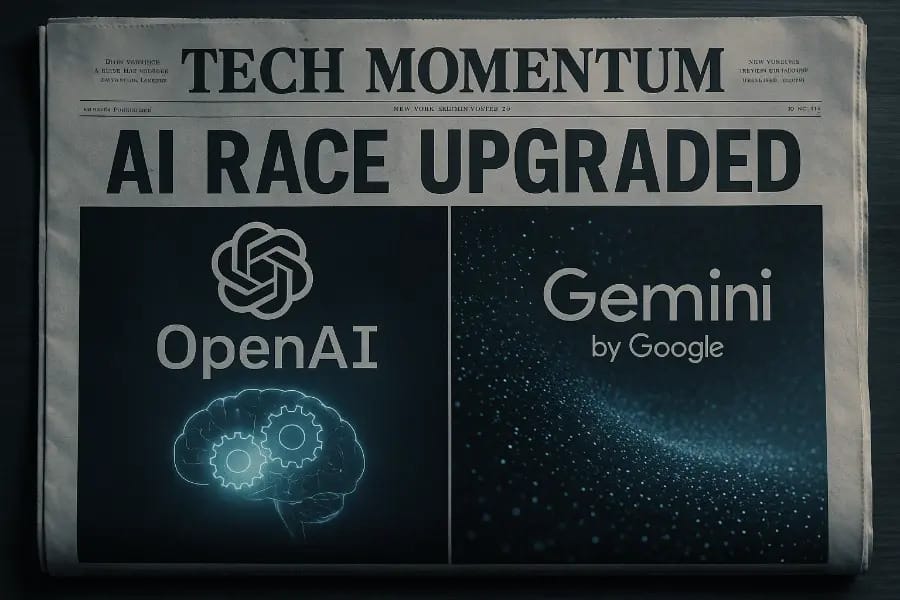- Tech Momentum
- Posts
- The GPT-5.1 Leak Explained
The GPT-5.1 Leak Explained
Learn how AI assistants now reason, plan, and respond autonomously — plus insights on GPT-5.1 and Google’s agent toolkit.

Welcome to Tech Momentum!
AI isn’t slowing down — it’s getting smarter, faster, and more human-like. From voice assistants that plan their own steps to Google’s new Go-based agent framework and a leaked OpenAI “thinking model,” the next leap isn’t about size — it’s about intelligence that reasons.
Here’s your inside track on the tech rewriting how AI works.
Updates and Insights for Today
You’ll Build a Voice AI That Thinks First
You’ll Out-Think AI with GPT-5.1
You’ll Build Smarter Agents With Go
The latest in AI tech
AI tools to checkout
AI News
You’ll Build a Voice AI That Thinks First
Quick Summary
This guide walks you through building an agentic voice AI that hears your command, reasons about it, sets a plan, then executes—end-to-end with speech. It uses models like Whisper (speech recognition) and SpeechT5 (text-to-speech) plus a Python pipeline.
Key Insights
The pipeline integrates: speech recognition → intent detection → multi-step reasoning → spoken response.
It demonstrates creating an agent class (e.g.,
VoiceAgent) that holds memory, context, tools, and goals.Uses open-source libraries (transformers, torch, torchaudio, soundfile, librosa) and voice models.
Designed for real-time interaction: listening to natural speech, identifying goal, planning, executing, then replying via voice.
Why It’s Relevant
If you’re building voice-driven interfaces or AI assistants (especially for your travel portal workflows, Tom), this article gives a clear blueprint to move from passive voice commands to agentic responses: your system can not just listen, but plan and act. It cuts down integration time by providing actual code and model links. It’s a practical jump from chat-bots to voice agents that engage multi-step logic and voice output.
📌 Read More: Marktechpost
The Simplest Way To Create and Launch AI Agents
Imagine if ChatGPT, Zapier, and Webflow all had a baby. That's Lindy.
With Lindy, you can build AI agents and apps in minutes simply by describing what you want in plain English.
→ "Create a booking platform for my business"
→ "Automate my sales outreach"
→ "Create a weekly summary about each employee's performance and send it as an email"
From inbound lead qualification to AI-powered customer support and full-blown apps, Lindy has hundreds of agents that are ready to work for you 24/7/365.
Stop doing repetitive tasks manually. Let Lindy automate workflows, save time, and grow your business.
You’ll Out-Think AI with GPT-5.1
Quick Summary
Leaked details suggest OpenAI is about to unveil a model codenamed GPT-5.1 “Thinking”, designed to handle deeper reasoning and multi-step plans. It appears targeted at competing with Gemini 3 Pro from Google, shifting focus from scale to cognitive depth.
Key Insights
Leaks show GPT-5.1 named “gpt-5-1‐thinking” surfaced in code for ChatGPT, indicating early testing.
Its main strength: deeper reasoning and strategic responses rather than just faster or larger output.
Google’s Gemini 3 Pro is expected to bring huge context windows (e.g., 1 million tokens) and multimodal skills — GPT-5.1 is positioned as a counter.
No official release date yet, but rumors point to late 2025 rollout, likely via gradual access to premium users.
Why It’s Relevant
For you, Tom, creating workflows and articles around AI tools, this signals a major shift in industry focus: not just “bigger is better” but “smarter thinking.” That means upcoming AI assistants may execute multi-step plans, reason across tasks, and offer strategic output — making your job easier but also increasing the need to evaluate capabilities and differentiate tools. Early adoption or coverage could give you an edge.
📌 Read More: TomsGuide
You’ll Build Smarter Agents With Go
Quick Summary
Agent Development Kit (ADK) by Google now supports Go, allowing you to code full-fledged AI agents in that language.
Key Insights
ADK is open-source and enables code-first development of AI agents with orchestration and tool use built directly into code.
The Go version is idiomatic and performant, leveraging Go’s concurrency and strong typing, on par with ADK’s Python & Java SDKs.
ADK Go includes native support for the Agent2Agent protocol (A2A), enabling multi-agent systems where agents delegate tasks among themselves.
It includes integration for over 30 databases via the MCP Toolbox, making agents capable of safe data operations and tool usage.
Why It’s Relevant
If you’re managing workflows and building AI-driven services (like your travel portal, Tom), this means you can now embed agent logic in Go back-end systems without switching to Python or Java. You’ll get better performance, easier version control, and access to Google Cloud’s agent lifecycle tooling (develop/test/deploy) all in one chain. It lowers friction and helps scale smarter agent implementations.
📌 Read More: Google
The latest in AI tech

1️⃣ OpenAI Warns: Prompt Injections Threaten AI Integrity
OpenAI exposes a growing risk in AI systems — prompt injections. Malicious instructions hidden inside user input can hijack AI behavior, leak data, or corrupt logic. Their new research outlines detection methods and safety principles developers must apply now. The message is clear: smarter AIs need smarter defenses.
📌 Read More: OpenAI
2️⃣ Nano Banana 2 Brings 4K AI Image Generation to Phones
Google’s next-gen Nano Banana 2 could make 4K AI image creation possible directly on your phone. Powered by Gemini 3 Pro’s imaging model, it merges text-to-image, style blending, and local compute for lightning-fast results. Expect professional visuals, instant edits, and full mobile creative freedom.
📌 Read More: TomsGuide
3️⃣ Sora by OpenAI Turns Words Into Realistic Video
Sora transforms text prompts into full videos, bringing professional video creation to everyday users. The app rocketed to #1 on Apple’s App Store, but also raises deepfake and ethics debates. It’s a glimpse of a near-future where video storytelling happens as fast as you can type.
📌 Read More: ABC-News
4️⃣ OpenAI Pushes to Expand U.S. Chips Act for Data Centers
OpenAI is urging Washington to extend the Chips Act tax credit beyond chip fabs to cover massive AI data-center infrastructure. This move highlights the soaring costs of scaling intelligence — and how AI economics are reshaping national tech policy. Infrastructure is now part of the AI race.
📌 Read More: TechCrunch
AI Tools to check out
Modelfy 3D – AI Image to 3D Model Generator
This web-tool turns any 2D image into a professional-grade 3D model (up to ~300 K polygons) with no manual modelling required.
👉 Try It Here: Modelfy
Surfn – No-code AI Agent Link Builder
Surfn lets you build and deploy branded AI agents (chatbots) via a simple link or embedded widget — no coding needed, integrates with your website, slides, or social.
👉 Try It Here: Surfn
UndetectedGPT – AI Content Humanizer & Detector-Bypass
This platform offers tools to transform AI-generated text into more human-like writing, plus detection checks to reduce AI-content flags.
👉 Try It Here: UndetectedGPT
Sensay – AI-Driven Knowledge Transfer Platform
Sensay helps organisations capture, retain and transfer tacit knowledge from departing employees via AI-interviews and structured exit workflows.
👉 Try It Here: Sensay
Thanks for sticking with us to the end!
We'd love to hear your thoughts on today's email!
Your feedback helps us improve our content
⭐⭐⭐Superb
⭐⭐Not bad
⭐ Could've been better
Not subscribed yet? Sign up here and send it to a colleague or friend!
See you in our next edition!
Tom





